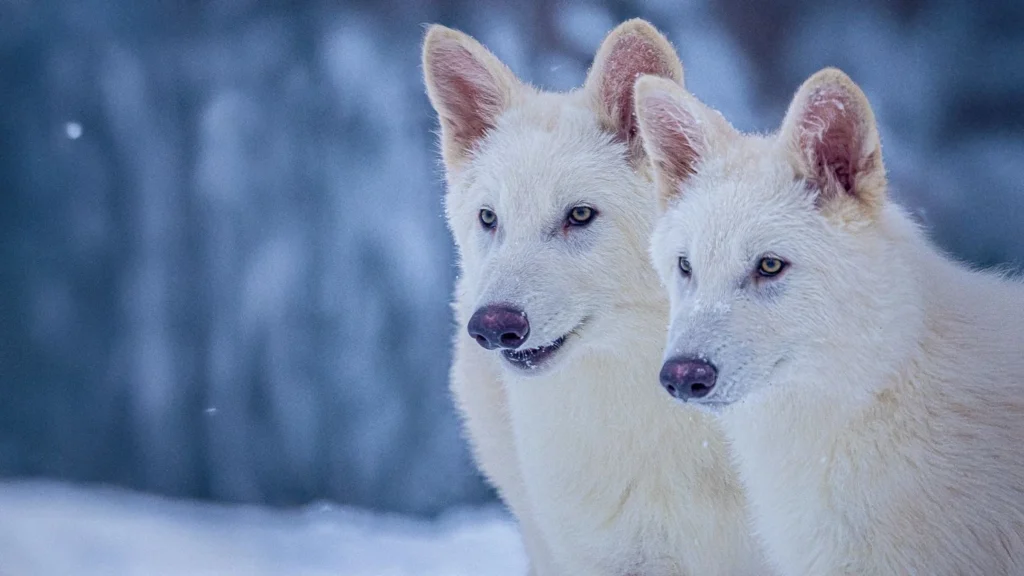NEWS
Ancient Predator Returns: Scientists Bring Back the Dire Wolf
Using advanced gene editing and cloning technologies, scientists have { brought a long-extinct animal back to life in a major breakthrough. A North Texas based biotech company, Colossal Biosciences, has tipped the world to its birth of three genetically-edited pups resembling dire wolves — an ancient predator that disappeared from the planet about 12,500 years ago. These puppies are what Colossal touts as the world’s first successfully “de-extincted” species. Although not pure dire wolves, these specimens are hybrids produced by making genetic alterations to gray wolves, the closest living relatives of the ancient canid, using data gleaned from ancient fossilized DNA.
The dire wolf, or Aenocyon dirus, prowled throughout North America and became an icon of pop culture, portrayed as the fearsome beast of HBO’s Game of Thrones. Compared to gray wolves, they were stockier, with broader skulls, thick light-colored fur and massive jaws. Colossal’s iteration, though not genetically identical to the original, possesses many of these distinctive traits through the use of cutting-edge gene-editing techniques.
To make this idea a reality, scientists from the company obtained ancient DNA samples from a 72,000-year-old skull and a 13,000-year-old tooth. Out of that, they were able to reconstruct high quality dire wolf genomes. They later compared this genetic information with the DNA from living canines, such as wolves, jackals and foxes, in search of specific traits that were unique to dire wolves. These were features such as the white coat, longer and denser fur and other body traits. The scientists used CRISPR gene-editing technology to introduce 20 precise changes to 14 genes in gray wolf cells. These modified cells were cloned and the resulting embryo implants into surrogate mothers.
Surprisingly, the surrogate mothers weren’t wolves but large mixed-breed domestic dogs. Anywho, three healthy pups were born as a result: two males, born October 1, 2024, and a female, born January 30, 2025. They now reside at a secure, undisclosed 2,000-acre property with zoo-style fencing, and are monitored continuously via cameras, drones and on-site personnel. It is certified by the American Humane Society and registered with the U.S. Department of Agriculture.
The company’s use of advanced cloning and gene editing is a major step forward in the field of de-extinction, according to experts such as Love Dalén, a professor of evolutionary genomics at Stockholm University and an advisor to Colossal. Although he admitted the hybrids aren’t exactly a dire wolf 100 percent, he claimed they are the closest we’ve come in 13,000 years to to bringing back this extinct species. “It has dire wolf genes and it looks more like a dire wolf than any thing we’ve seen,” Dalén said, calling the achievement a giant leap forward.
The term “de-extinction,” has divided the scientific community, with some critics arguing that the animals are hybrids and not true copies of the extinct species. Critics also argue about whether such costly projects are the best way to allocate funding at a time when many living species are facing extinction today. Yet Colossal argues that the same techniques could save endangered species. The company, for one, has clones to thank for two litters of red wolf puppies—one of the most endangered species of canid in the country—bolstering the case for approaching struggling animal populations with its new cloning process.
Environmental ethicists have debated the issue, as well. Christopher Preston, a University of Montana professor, said Colossal has demonstrated concern for animal welfare, including the facility where the animals will be kept, the backing of humane apologists, and a proposed effort to avoid genetically detrimental outcomes. But he also expressed skepticism about how such new creatures might fit into modern ecosystems. “In states like Montana, we are already fighting to keep stable populations of gray wolves due (to) political opposition,” Preston said. “It’s pretty much impossible to envision these dire wolves being spawned and released into the wild to play any genuine role in an ecosystem.”
Colossal has raised north of $435 million since being founded in 2021 by the entrepreneur Ben Lamm and the Harvard geneticist George Church. While the company’s earlier attempts to revive animals such as the woolly mammoth, the dodo and the Tasmanian tiger have not yet come to fruition, this milestone advances its goal of restoring extinct species and possibly to use this knowledge to prevent endangered species from going the same way.
And it satisfies the paradox that while the dire wolf pups will never roam the wild as their forbearers did, their being is a remarkable moment in science, combining the ancient with the futuristic. Whether the world is prepared for this sort of species revival is an unknown, but for now at least these pups are living evidence that extinction may not be quite as final as we once believed.